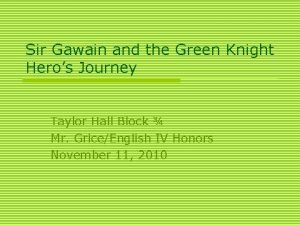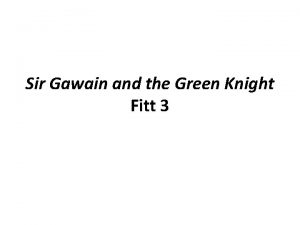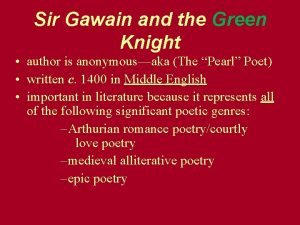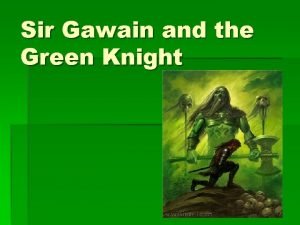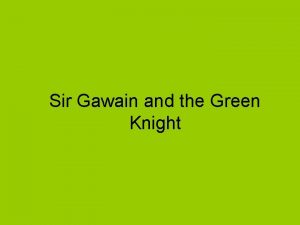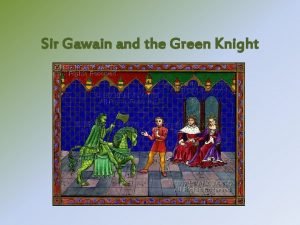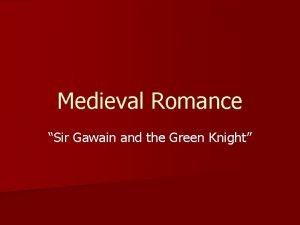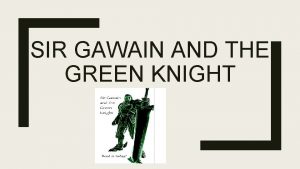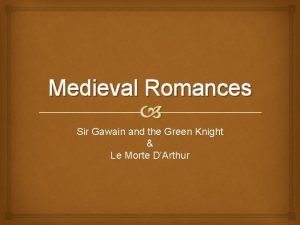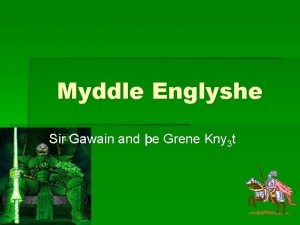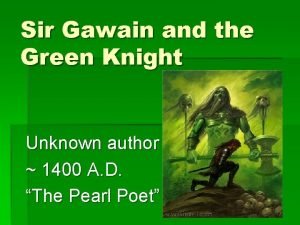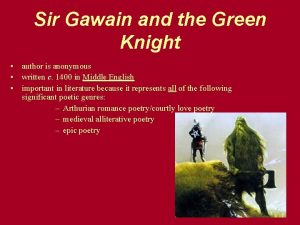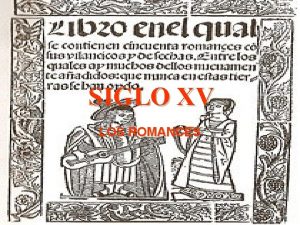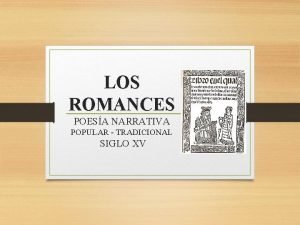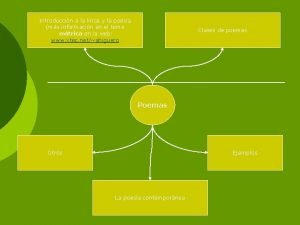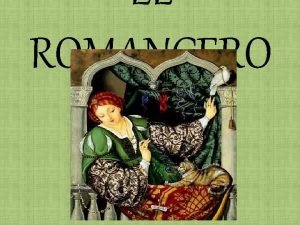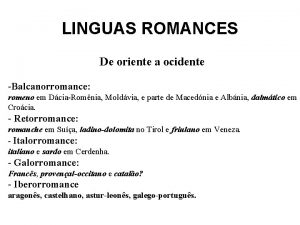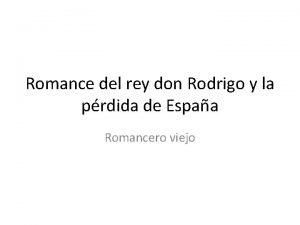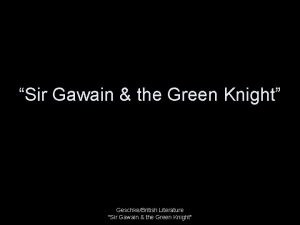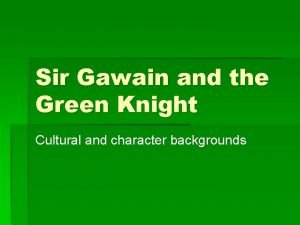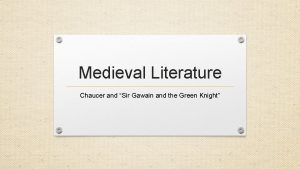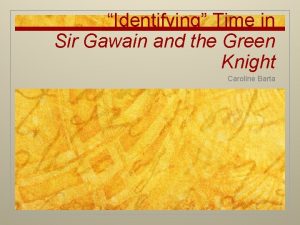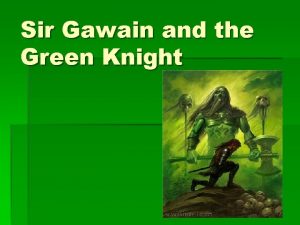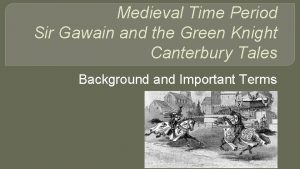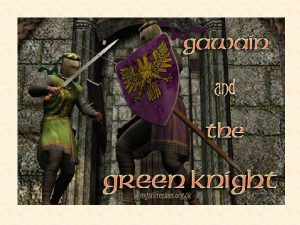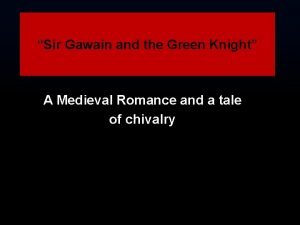Romances Sir Gawain and the Contents Sir Gawain
























- Slides: 24

Romances Sir Gawain and the

Contents: -Sir Gawain and the Green Knight -The nature of Chivalry

Sir Gawain and the Green Knight

Summery of the plot During a New Year’s Eve feast at King Arthur’s court, a strange figure, referred to only as the Green Knight, pays the court an unexpected visit. He challenges the group’s leader or any other brave representative to a game. The Green Knight says that he will allow whomever accepts the challenge to strike him with his own axe, on the condition that the challenger find him in exactly one year to receive a blow in return. Stunned, Arthur hesitates to respond, but when the Green Knight mocks Arthur’s silence, the king steps forward to take the challenge. As soon as Arthur grips the Green Knight’s axe, Sir Gawain leaps up and asks to take the challenge himself. He takes hold of the axe and, in one deadly blow, cuts off the knight’s head. To the amazement of the court, the now-headless Green Knight picks up his severed head. Before riding away, the head reiterates the terms of the pact, reminding the young Gawain to seek him in a year and a day at the Green Chapel. After the Green Knight leaves, the company goes back to its festival, but Gawain is uneasy. Time passes, and autumn arrives. On the Day of All Saints, Gawain prepares to leave Camelot and find the Green Knight. He puts on his best armour, mounts his horse, Gringolet, and starts off toward North Wales, travelling through the wilderness of northwest Britain. Gawain encounters all sorts of beasts, suffers from hunger and cold, and grows more desperate as the days pass. On Christmas Day, he prays to find a place to hear Mass, then looks up to see a castle shimmering in the distance. The lord of the castle welcomes Gawain warmly, introducing him to his lady and to the old woman who sits beside her. For sport, the host (whose name is later revealed to be Bertilak) strikes a deal with Gawain: the host will go out hunting with his men every day, and when he returns in the evening, he will exchange his winnings for anything Gawain has managed to acquire by staying behind at the castle. Gawain happily agrees to the pact, and goes to bed.

The first day, the lord hunts a herd of does, while Gawain sleeps late in his bedchambers. On the morning of the first day, the lord’s wife sneaks into Gawain’s chambers and attempts to seduce him. Gawain puts her off, but before she leaves she steals one kiss from him. That evening, when the host gives Gawain the venison he has captured, Gawain kisses him, since he has won one kiss from the lady. The second day, the lord hunts a wild boar. The lady again enters Gawain’s chambers, and this time she kisses Gawain twice. That evening Gawain gives the host the two kisses in exchange for the boar’s head. The third day, the lord hunts a fox, and the lady kisses Gawain three times. She also asks him for a love token, such as a ring or a glove. Gawain refuses to give her anything and refuses to take anything from her, until the lady mentions her girdle. The green silk girdle she wears around her waist is no ordinary piece of cloth, the lady claims, but possesses the magical ability to protect the person who wears it from death. Intrigued, Gawain accepts the cloth, but when it comes time to exchange his winnings with the host, Gawain gives the three kisses but does not mention the lady’s green girdle. The host gives Gawain the fox skin he won that day, and they all go to bed happy, but weighed down with the fact that Gawain must leave for the Green Chapel the following morning to find the Green Knight.


New Year’s Day arrives, and Gawain dons his armor, including the girdle, then sets off with Gringolet to seek the Green Knight. A guide accompanies him out of the estate grounds. When they reach the border of the forest, the guide promises not to tell anyone if Gawain decides to give up the quest. Gawain refuses, determined to meet his fate head-on. Eventually, he comes to a kind of crevice in a rock, visible through the tall grasses. He hears the whirring of a grindstone, confirming his suspicion that this strange cavern is in fact the Green Chapel. Gawain calls out, and the Green Knight emerges to greet him. Intent on fulfilling the terms of the contract, Gawain presents his neck to the Green Knight, who proceeds to feign two blows. On the third feint, the Green Knight nicks Gawain’s neck, barely drawing blood. Angered, Gawain shouts that their contract has been met, but the Green Knight merely laughs. The Green Knight reveals his name, Bertilak, and explains that he is the lord of the castle where Gawain recently stayed. Because Gawain did not honestly exchange all of his winnings on the third day, Bertilak drew blood on his third blow. Nevertheless, Gawain has proven himself a worthy knight, without equal in all the land. When Gawain questions Bertilak further, Bertilak explains that the old woman at the castle is really Morgan le Faye, Gawain’s aunt and King Arthur’s half sister. She sent the Green Knight on his original errand used her magic to change Bertilak’s appearance. Relieved to be alive but extremely guilty about his sinful failure to tell the whole truth, Gawain wears the girdle on his arm as a reminder of his own failure. He returns to Arthur’s court, where all the knights join Gawain, wearing girdles on their arms to show their support.

Main Characters Gawain Though Gawain and Guinevere share the high table at the New Year’s celebration in Arthur’s court, he describes himself as the least of Arthur’s knights in terms of both physical prowess and mental ability. His modest claim to inferiority and his high status at court—he is Arthur’s nephew and one of Camelot’s most famous knights—testify to both his humility and his ambition. Gawain seeks to improve his inner self throughout the poem. After Gawain arrives at Bertilak’s castle in Part 2, it is evident that his reputation is quite widespread. To Gawain, his public reputation is as important as his own opinion of himself, and he therefore insists on wearing the green girdle as a sign of shame at the story’s end. He believes that sins should be as visible as virtues. Even though the Green Knight essentially tricks Gawain by not telling him about his supernatural abilities before asking Gawain to agree to his terms, Gawain refuses to back out of their deal. He stands by his commitments absolutely, even when it means jeopardizing his own life. The poem frequently reiterates Gawain’s deep fears and anxieties, but Gawain’s desire to maintain his personal integrity at all costs enables him to conquer his fears in his quest for the Green Knight.

Gawain is a paragon of virtue in Parts 1 and 2 of the poem. But in Part 3 he conceals from his host the magical green girdle that the host’s wife gives him, revealing that, despite his bravery, Gawain values his own life more than his honesty. Ultimately, however, Gawain confesses his sin to the knight and begs to be pardoned; thereafter, he voluntarily wears the girdle as a symbol of his sin. Because Gawain repents of his sin in such an honorable manner, his one indiscretion in the poem actually ends up being an example of his basic goodness. Gawain is not a static character. In his encounter with the Green Knight, he recognizes the problematic nature of courtly ideals. When he returns to Arthur’s court at Camelot, the other lords and ladies still look to him like lighthearted children, but Gawain is weighed down by a new somberness. Though he survives his quest, Gawain emerges at the end of the poem as a humbled man who realizes his own faults and has to live with the fact that he will never live up to his own high standards.

Sir Gawain The Green Knight

Green Knight - A mysterious visitor to Camelot. The Green Knight’s huge stature, wild appearance, and green complexion set him apart from the beardless knights and beautiful ladies of Arthur’s Camelot. He is an ambiguous figure: he says that he comes in friendship, not wanting to fight, but the friendly game he proposes is quite deadly. He attaches great importance to verbal contracts, expecting Sir Gawain to go to great lengths to hold up his end of their bargain. The Green Knight shows himself to be a supernatural being when he picks up his own severed head and rides out of Arthur’s court, still speaking. At the same time, he seems to symbolize the natural world, in that he is killed and reborn as part of a cycle. At the poem’s end, we discover that the Green Knight is also Bertilak, Gawain’s host, and one of Morgan le Faye’s minions.

Bertilak of Hautdesert - The sturdy, good-natured lord of the castle where Gawain spends Christmas. We only learn Bertilak’s name at the end of Sir Gawain and the Green Knight. The poem associates Bertilak with the natural world —his beard resembles a beaver, his face a fire—but also with the courtly behavior of an aristocratic host. Boisterous, powerful, brave, and generous, Lord Bertilak provides an interesting foil to King Arthur. At the end of the poem we learn that Bertilak and the Green Knight are the same person, magically enchanted by Morgan le Faye for her own designs. The Green Knight (also known as Bertilak de Hautdesert and the Host) (In-Depth Analysis) Bertilak’s wife - Bertilak’s wife attempts to seduce Gawain on a daily basis during his stay at the castle. Though the poem presents her to the reader as no more than a beautiful young woman, Bertilak’s wife is an amazingly clever debater and an astute reader of Gawain’s responses as she argues her way through three attempted seductions. Flirtatious and intelligent, Bertilak’s wife ultimately turns out to be another pawn in Morgan le Faye’s plot.

Morgan le Faye - The Arthurian tradition typically portrays Morgan as a powerful sorceress, trained by Merlin, as well as the half sister of King Arthur. Not until the last one hundred lines do we discover that the old woman at the castle is Morgan le Faye and that she has controlled the poem’s entire action from beginning to end. As she often does in Arthurian literature, Morgan appears as an enemy of Camelot, one who aims to cause as much trouble for her half brother and his followers as she can.

King Arthur - The king of Camelot. In Sir Gawain and the Green Knight, Arthur is young and beardless, and his court is in its golden age. Arthur’s refusal to eat until he hears a fantastic tale shows the petulance of youth, as does Arthur’s initial stunned response to the Green Knight’s challenge. However, like a good king, Arthur soon steps forward to take on the challenge. At the story’s end, Arthur joins his nephew in wearing a green girdle on his arm, showing that Gawain’s trial has taught him about his own fallibility. Queen Guinevere - Arthur’s wife. The beautiful young Guinevere of Sir Gawain and the Green Knight seems to have little in common with the one of later Arthurian legend. She sits next to Gawain at the New Year’s feast and remains a silent, objectified presence in the midst of the knights of the Round Table.

Who was the poet? Sir Gawain and the Green Knight was composed in the late fourteenth century. The poet’s name is unknown, but it referred to as ‘the Pearl poet’ since he also wrote ‘The Pearl’. He was probably a member of a court since he is so familiar with court life, costumes and entertainments The poet was a contemporary of Chauser, and he wrote in a Northwest Midland’s dialect much less modern than the London dialect of Chauser.

Conventions of the Romance The term romance was coined to distinguish popular material in the vernacular from scholarly and ecclesiastical literature in Latin. The boundaries between the romance and the chansons de geste of the troubadours were somewhat fluid. In general, the chansons were the property of professional performers, while the romance was associated more with amateurs and private readers. Unlike the novel and like the chansons de geste, the romance dealt with traditional themes, above all three thematic cycles of dealt with traditional themes, tales- the matter of Rome (Alexander the Great), the matter of Britain ( King Arthur and the knights of the round table, within which was incorporated the quest for Holy Grail) and the matter of France( Charlemagne and Rolland). Romances can have a teaching function in relation to moral and social values, but more importantly , they serve to establish an identity for a group, be it an ethnic group or a social class

The Green Knight as Fertility God The Green Knight is rather seen by many like a fertility god. Stories of ancient fertility gods that have survived in Greek and Middle Eastern myths demonstrate ancient people’s belief that a god was in charge of all that grew and died. The fertility god was believed to fallow the pattern observable in nature: - winter and death of all vegetation - followed by spring and the rebirth or regeneration of the land. This death followed by rebirth was believed to be caused by a fertility god who dies in winter but comes alive again in spring in a never-ending cycle. The Green Knight is portrayed with the trappings or symbols of The Green Knight is fertility. First, he is green, the colour of the land in the spring and summer. Second, his clothes are embroidered in gold, the colour of the sun, without whose warmth and light no life on earth could endure. Third, he wears a holly which is a plant that does no die in winter. Fourth, his beard is like a bush. The Green Knight’s as a figure of the life force is key to the meaning of the poem.

Structure of the Poem The poem is constructed on a series of contrasts, such as: Court life, a haven of safety, refinement, order, culture, pleasure and entertainment The Outside World, harsh nature, battles to be fought, wild animals, bad weather, war, chaos

The nature of Chivalry The world of Sir Gawain and the Green Knight is governed by well-defined codes of behaviour. The code of chivalry, in particular, shapes the values and actions of Sir Gawain and other characters in the poem. The ideals of chivalry derive from the Christian concept of morality, and the proponents of chivalry seek to promote spiritual ideals in a spiritually fallen world. The ideals of Christian morality and knightly chivalry are brought together in Gawain’s symbolic shield. The pentangle represents the five virtues of knights: friendship, generosity, chastity, courtesy, and piety. Gawain’s adherence to these virtues is tested throughout the poem, but the poem examines more than Gawain’s personal virtue; it asks whether heavenly virtue can operate in a fallen world. What is really being tested in Sir Gawain and the Green Knight might be the chivalric system itself, symbolized by Camelot. Arthur’s court depends heavily on the code of chivalry, and Sir Gawain and the Arthur’s court Green Knight gently criticizes the fact that chivalry values appearance and symbols over truth. Arthur is introduced to us as the “most courteous of all, ” indicating that people are ranked in this court according to their mastery of a certain code of behavior and good manners. When the Green Knight challenges the court, he mocks them for being so afraid of mere words, suggesting that words and appearances hold too much power over the company. The members of the court never reveal their true feelings, instead choosing to seem beautiful, courteous, and fair-spoken.

On his quest for the Green Chapel, Gawain travels from Camelot into the wilderness. In the forest, Gawain must abandon the codes of chivalry and admit that his animal nature requires him to seek physical comfort in order to survive. Once he prays for help, he is rewarded by the appearance of a castle. The inhabitants of Bertilak’s castle teach Gawain about a kind of chivalry that is more firmly based in truth and reality than that of Arthur’s court. These people are connected to nature, as their hunting and even the way the servants greet Gawain by kneeling on the “naked earth” symbolize. The poem does not by any means suggest that the codes of chivalry be abandoned. Gawain’s adherence to them is what keeps him from sleeping with his host’s wife. The lesson Gawain learns as a result of the sleeping with Green Knight’s challenge is that, at a basic level, he is just a physical being who is concerned above all else with his own life. Chivalry provides a valuable set of ideals toward which to strive, but a person must above all remain conscious of his or her own mortality and weakness. Gawain’s time in the wilderness, his flinching at the Green Knight’s axe, and his acceptance of the lady’s offering of the green girdle teach him that though he may be the most chivalrous knight in the land, he is nevertheless human and capable of error.

The Letter of the Law Though the Green Knight refers to his challenge as a “game, ” he uses the language of the law to bind Gawain into an agreement with him. He repeatedly uses the word “covenant, ” meaning a set of laws, a word that evokes the two covenants represented by the Old and the New Testaments. The Old Testament details the covenant made between God and the people of Israel through Abraham, but the New Testament replaces the old covenant with a new covenant between Christ and his followers. In 2 Corinthians 3: 6, Paul writes that Christ has “a new covenant, not of letter but of spirit; for the letter kills, but the Spirit gives life. ” The “letter” to which Paul refers here is the legal system of the Old Testament. From this statement comes the Christian belief that the literal enforcement of the law is less important than serving its spirit, a spirit tempered by mercy. Throughout most of the poem, the covenant between Gawain and the Green Knight evokes the literal kind of legal enforcement that medieval Green Knight Europeans might have associated with the Old Testament. The Green Knight at first seems concerned solely with the letter of the law. Even though he has tricked Gawain into their covenant, he expects Gawain to follow through on the agreement. And Gawain, though he knows that following the letter of the law means death, is determined to see his agreement through to the end because he sees this as his knightly duty.

At the poem’s end, the covenant takes on a new meaning and resembles the less literal, more merciful New Testament covenant between Christ and his Church. In a decidedly Christian gesture, the Green Knight, who is actually Gawain’s host, Bertilak, absolves Gawain because Gawain has confessed his faults. To remind Gawain of his weakness, the Green Knight gives him a penance, in the form of the wound on his neck and the girdle. The Green Knight punishes Gawain for breaking his covenant to share all his winnings with his host, but he does not follow to the letter his covenant to decapitate Gawain. Instead of chopping Gawain’s head off, Bertilak calls it his right to spare Gawain and only nicks his neck. Ultimately, Gawain clings to the letter of the law. He cannot accept his sin and absolve himself of it the way Bertilak has, accept and he continues to do penance by wearing the girdle for the rest of his life. The Green Knight transforms his literal covenant by offering Gawain justice tempered with mercy, but the letter of the law still threatens in the story’s background, and in Gawain’s own psyche.

Motifs are recurring structures, contrasts, or literary devices that can help to develop and inform the text’s major themes. The Seasons At the beginning of Parts 2 and 4, the poet describes the changing of the seasons. The seasonal imagery in Part 2 precedes Gawain’s departure from Camelot, and in Part 4 his departure from the host’s castle. In both cases, the changing seasons correspond to Gawain’s changing psychological state, from cheerfulness (pleasant weather) to bleakness (the winter). But the five changing seasons also correspond to the five ages of man (birth/infancy, youth, adulthood, middle age, and old age/death), as well as to the cycles of fertility and decay that govern all creatures in the natural world. The emphasis on the cyclical nature of the seasons contrasts with and provides a different understanding of the passage of time from the more linear narrative of history that frames the poem. Games When the poem opens, Arthur’s court is engaged in feast-time customs, and When Arthur almost seems to elicit the Green Knight’s entrance by requesting that someone tell him a tale. When the Green Knight first enters, the courtiers think that his appearance signals a game of some sort. The Green Knight’s challenge, the host’s later challenge, and the wordplay that takes place between Gawain and the lady are all presented as games. The relationship between games and tests is explored because games are forms of social behavior, while tests provide a measure of an individual’s inner worth.

Symbols are objects, characters, figures, or colours used to represent abstract ideas or concepts. The Pentangle- According to the Gawain-poet, King Solomon originally designed the five-pointed star as his own magic seal. A symbol of truth, the star has five points that link and lock with each other, forming what is called the endless knot. Each line of the pentangle passes over one line and under one line, and joins the other two lines at its ends. The pentangle symbolizes the virtues to which Gawain aspires: to be faultless in his five senses; never to fail in his five fingers; to be faithful to the five wounds that Christ received on the cross; to be strengthened by the five joys that the Virgin Mary had in Jesus (the Annunciation, Nativity, Resurrection, Ascension, and Assumption); and to possess brotherly love, courtesy, piety, and chastity. The side of the shield facing Gawain contains an image of the Virgin Mary to make sure that Gawain never loses heart. make sure that The Green Girdle- The meaning of the host’s wife’s girdle changes over the course of the narrative. It is made out of green silk and embroidered with gold thread, colours that link it to the Green Knight. She claims it possesses the power to keep its wearer from harm, but we find out in Part 4 that the girdle has no magical properties. After the Green Knight reveals his identity as the host, Gawain curses the girdle as representing cowardice and an excessive love of mortal life. He wears it from then on as a badge of his sinfulness. To show their support, Arthur and his followers wear green silk baldrics that look just like Gawain’s girdle.
 Hero's journey sir gawain and the green knight
Hero's journey sir gawain and the green knight Sir gawain and the green knight fitt 3
Sir gawain and the green knight fitt 3 Symbology
Symbology Who is the antagonist in sir gawain and the green knight
Who is the antagonist in sir gawain and the green knight Is sir gawain and the green knight a medieval romance
Is sir gawain and the green knight a medieval romance Romance of sir gawain and the green knight
Romance of sir gawain and the green knight Sir gawain and the green knight vocabulary
Sir gawain and the green knight vocabulary Bob and wheel
Bob and wheel Read the excerpt from sir gawain and the green knight
Read the excerpt from sir gawain and the green knight Bercilak de hautdesert
Bercilak de hautdesert Sir gawain medieval romance
Sir gawain medieval romance Sir gawain and the green knight hero's journey
Sir gawain and the green knight hero's journey How to pronounce sir gawain
How to pronounce sir gawain Sir gawain theme
Sir gawain theme Sir gawain author
Sir gawain author Romances siglo xv
Romances siglo xv Clasificacion de los romances
Clasificacion de los romances Ejemplos de el romance
Ejemplos de el romance Clasificacion de romances
Clasificacion de romances Linguas romances
Linguas romances Romance de don rodrigo
Romance de don rodrigo Fuvest poderiamos sintetizar uma das caracteristicas
Fuvest poderiamos sintetizar uma das caracteristicas Lenguas romances
Lenguas romances Hát kết hợp bộ gõ cơ thể
Hát kết hợp bộ gõ cơ thể Ng-html
Ng-html
